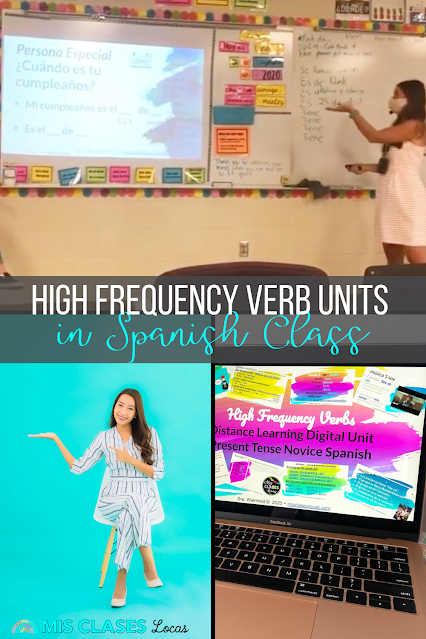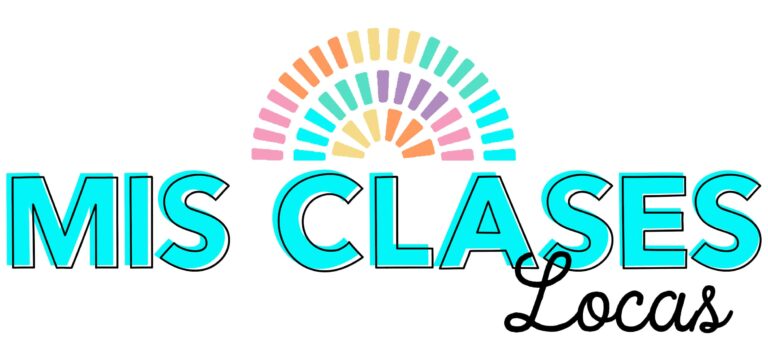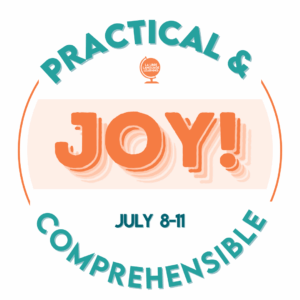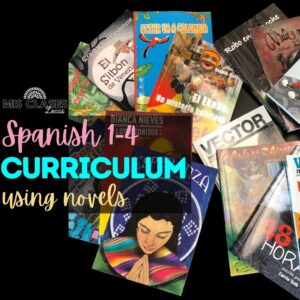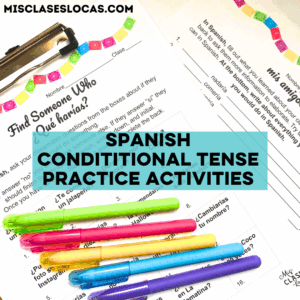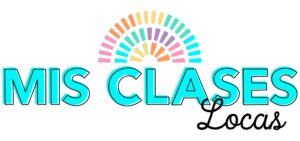Inside: How to use high frequency words (Spanish Super 7 & Sweet 16) in a comprehensible input-based Spanish language class.
Author – Allison Wienhold
Originally posted 4.9.18 most recently updated 1.13.25

High Frequency Verb Units using High Frequency Words
A few summers ago I posted about a Super 7 unit to start Spanish class. Then I shared my 1st-week reflections with how I would tweak it. I used that present tense Super 7 unit multiple years to start Spanish 1. Additionally for all four sections of my exploratory Spanish, one each quarter. This means in the first school year alone using it, I did five rounds of special person interviews using Spanish high frequency words.
What are the Super 7 Verbs in Spanish?
These 7 Spanish words will help students communicate right away! If you have sight word lists for students, these important verbs should be on them!
- 1 es (is)
- 2 tiene (has)
- 3 le gusta (likes / is pleasing to)
- 4 hay (there is / there are)
- 5 está (is at a place / is feeling)
- 6 va (goes / is going)
- 7 quiere (wants)
My High Frequency Word Unit to Start Spanish 1
My High Frequency Verb Unit lesson plans were based around the Super 7 es, tiene, le gusta, hay, está, va a & quiere (from Terry Waltz). I introduce them in this order. Honestly, it never gets old because with every interview I learn more about my students and we become more of a positive classroom family. You may consider these palabras de uso frecuente o palabras de alta frecuencia Spanish sight words.
After doing this unit so many times, here is the formula that I have found has worked best for my novice, non-heritage speaking students and me using the specific units that I have created in person. (To learn more about persona especial interviews, check out the blog of the creator Bryce Hedstrom+ my Persona Especial blog).
IN-PERSON SUPER 7 UNIT PLANS
Below are the plans used for any of the following in-person units
- Present Tense Novice Spanish – Super 7 High Frequency Verb Unit
- Sweet 16 – present – High Frequency Verb Unit
- Imperfect Tense Spanish – High Frequency verb Unit
- Preterite Tense Spanish – High Frequency verb Unit
- Future Tense Spanish- High Frequency verb unit
Introduce the high frequency focus vocabulary
Intro the focus vocab of the day, which is written on my board to reference.
Persona Especial Interview
A special person is asked a personalized question using that target structure in a slideshow (idea from Kara Jacobs). I use my clicker, which prompts their first-person answer. Then the class chorally states the information back. We circle the information until we feel comfortable moving on. Learn more about Persona Especial.
The rest of the students sit in a semi-circle without anything on their laps. They do not take notes and their job is to listen to understand and interact. I jot down notes on the whiteboard as we go. (Or you could have this as a student job).
Song Brain Break
Once we are done interviewing, we give the student a positive validation and do a brain break. For each target structure, I have a song with many repetitions of that structure. Here are a couple of ways we have used the song:
- Students tally the number of times they hear the word
- Students stand up and jump every time they hear the word
- Students raise their hands every time they hear the word
- Students stand up every time they hear the word
Notes over Special Person
Then students grab their guided notes sheet and a clipboard and take down the notes over our special person that are written on the board including the new words. Or you could have students work alone, in pairs, or in small groups to take down notes open-ended style as more of a free write.
What to do next with the (possible) extra time?
At that point depending on how much time is left, we may do another interview, or go on to do a different activity. For example, I had an 8th-grade class that worked on nuggets of the Sr. Wooly song “Guapo” during this unit with extra time, as it ties in great with the vocabulary and mixes it up for a group that could not just sit and does interviews all day each day. I know some teachers have used this unit as a review or with heritage speakers, going quite quickly through all questions, and interviewing many people in a day.
What if you need to mix up doing persona especial interviews?
We do a few days of interviews, and then mix up the routine with a story asking using the same vocabulary in a new and fresh way. We do some activities with the story, and then return to do more interviews, ending with an assessment.
Sometimes we do a mid-way assessment, where I list the students who have gone and list a few interesting facts in Spanish that they need to match up.
To review for the assessments, or to come back to the vocabulary later in the year, I have a Find Someone Who to interview many people or just a partner. In the end, we do a free write, where they write everything they can about a person of their choice.
I also use the newer Spanish Conversation High-frequency Words Cards to get students up and moving while asking and answering the questions.
NEW! – Google Slides review activity – great for a sub-plan or to review the unit.
What if I want to go beyond the present tense Super 7?
With the success of this unit, I decided to create more. I introduced the past tense to Spanish two last fall with a unit using the Super 7 unit using the imperfect. Then after a request, I made one for the Preterite as well. (Another teacher recently posted that she has students send her pictures of themselves as kids to project and add something extra special to the interviews). If you are wanting all 3 of the Super 7 units, along with the accompanying Find Someone Who activities, there is the Super 7 Bundle.
Spanish Sweet 16
I expanded the present tense with a Sweet 16 unit. It expands on the Super 7 and includes the verbs, not in the Super 7 (le da, le dice, hace, puede, pone, sabe, sale, trae, ve, oye, viene as identified by Mike Peto). There is also a Find Someone Who with the same vocabulary. My goal is to come back to this unit later in Spanish 1, or to do one interview to start class per day, while working on other things too.
High Frequency Verb Bundles
If you want a specific tense, there is a present tense bundle or a past tense bundle as well. The newest of these is a Future tense unit.
Looking for other World Languages? I also now have the Super 7 Unit in French too!
What if I want to display these High Frequency verbs in Spanish?
I finally put together my popular simple bulletin board in a free download. I created it in 2015, so I guess it is time to let you download it too! It is very basic, using very little black ink. You can print it on your favorite colored paper. The English are optional if you want to add and remove it when your students are ready. If you use this download and enjoy it, give some love and leave positive feedback, or post it on social media and tag @misclaseslocas so I can see it too.
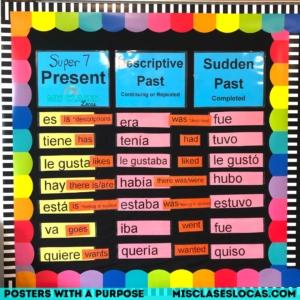
DISTANCE OR HYBRID LEARNING PLANS
using any of the following distance or hybrid units
- High-frequency PRESENT unit 1 – Super 7
- High-frequency PRESENT unit 2 – Sweet 16
- IMPERFECT unit
- PRETERITE unit
What if I want to use these verbs, but am doing distance or blended learning?
>>> The distance learning high-frequency units BUNDLE
Everything you need for digital learning using the same verbs. This includes all of my newer digital Super 7/Sweet 16 resources. They could stand-alone digital Slides. Or mix with the resources from the original units for more of a hybrid setting.
>>> Mega Bundle of all High-Frequency Resources for Spanish curriculum
This bundle has every Super 7 & Sweet 16 resource I have created. It includes both in-person and digital learning. It would help you be prepared for any situation and every level you teach with. Including the original units, distance units, and, Find Someone Who, all recycling the same material. It will help you be prepared with some paper activities if you get a chance to see students in person, as well as digitally while learning remotely.
>>> Blog post for distance variations shared by many teachers
My Example Blended Learning Hybrid for Spanish 1 (fall 2020)
(Super 7 present unit on a block of in-class & then online supplement the next day)
- This post goes into detail about how on our block schedule we do one verb per day between our 99 minutes in-person block, and an hour of supplemental work the following day. I posted the whole slideshow on Google Classroom in advance, adding daily agendas like the one below.
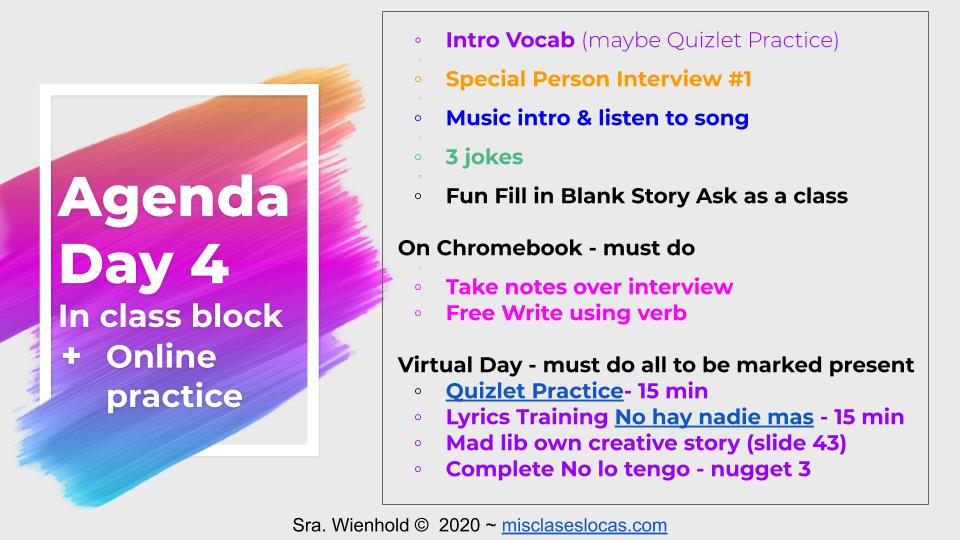
- I focus on the in-person heavy input when I have them with me. this means vocabulary introduction, personalized questions to practice, special person interviews, introducing the song, brain break with song, discussing jokes, story, and free write.
- On virtual days, students do more individual practice. this includes Quizlet practice, Lyrics training with songs, story videos, watching special person interviews again, completing joke reflections in slides, as well a nugget each day for No Lo Tengo from Sr. Wooly.
- I spent about one month using this unit. I had students 7 days in person for 99 minutes every other day. Then working on individual online practice on the opposite 7 days. Finally, we had another block for review & assessments.
Review & Assessment
- Google Form reading quiz – For an assessment over the special person interviews about halfway after the fourth verb we did a Google Form Quiz. I just typed up statements about students with multiple choice of the students who had gone. (Then just copy the question and change the statement to save typing up the options again). If you use it in quiz mode and assign points, it is easy and self-grading!
- **Brand NEW! – Google Slides review activity – great for a sub-plan or to review the unit.
- Review of the unit & verbs – On our last day of the unit, we did the Find Someone Who in partners with the TPT digital add-on. See this post on how to use the add-on. I first assigned one question page and one answers page. You can then differentiate on if your students need the support of sentence starters or not. next, students wrote about themselves on the first page to practice being interviewed. Students then interviewed each other using the questions and writing about the partner on the second page. We did this in person with masks, but you could have students meet digitally to interview in breakout rooms as well. (You could also do something similar with the Question Cards. You can laminate them & have multiple sets.
For summative assessments of High Frequncy Verb Units
- Writing – Students just did a free write about one of the special people (& they could compare to themselves if they wanted). The goal was 10 sentences. I graded it using a proficiency-based rubric.
- Speaking – I asked students a few random questions from the Question Cards. Due to small classes, I just pulled one at a time to my desk with a mask to ask them while others were writing. You could also do this in pairs with students asking each other. If you are online students could sign up for a time or join a meeting room with you to do the assessment. Another option would be to use Flipgrid with question prompts for students to answer.
What if my classes are not into the special person interviews or do I want to mix it up?
- You can do the unit without interviews! Mix up how you use the questions!
- This winter my Spanish 2 class was introduced to the imperfect tense using my Imperfect Super 7 Blended Bundle. I broke up the Imperfect Digital Slides, posting all of the slides for 2 verbs for each block. (If I had a traditional class length I would do one verb each class for my Spanish 2).
- Instead of interviews, students worked in pairs or small groups to interview each other & recorded answers on the question slides. Then they introduced their partner to the class or another small group.
- Our class flow for this unit each day was usually:
- Slides were posted in Classroom with students working both in class and via zoom. (You could use PearDeck or Nearpod too)
- Blooket review/intro next verb
- Partner or small group interviews using questions.
- Song brain break for all.
- Students worked alone or with a partner to complete reading practice, and then did daily free write.
- They turned in the days Google Slides on Classroom.
- As a review, they did the Find Someone Who using the TPT Easel Digital overlay.
- For an assessment, they did a free write using the imperfect to write about both them and someone else.
- Finally, what I have found is so great about these units is they have helped many teachers who are newer to CI techniques to feel more comfortable with doing special person interviews. The structure of having planned questions and not having to think as much on your feet is comforting to those starting out. For example, I had a one-week university practicum student who watched me use it one day. Then they confidently jumped in on day two leading a special person interview for the first time ever like a long-time pro. For those with more experience, it provides a starting point, to which you can extemporaneously add more as needed.
What if I teach Spanish Immersion?
I have personally used variations of this Super 7 unit with middle school Spanish & High School Spanish. But, I know teachers who use Spanish immersion have used variations of this unit focusing on Spanish high frequency words. A Spanish literacy classroom could use these questions to get to know students. Depending on the grade level native English speakers could pick up on answering personalized questions. It might not be best if you teach an early reader or young readers such as 1st grade or 2nd grade.
For upper elementary on up this is a great way to practice language skills with a k-12 student.
I have also see teachers have success using these units with adult education or higher education.
-
Super 7 FAQ Video
- This video goes through common FAQs using the original units as well.
(Please know it was my first ever attempt at Facebook Live:)
